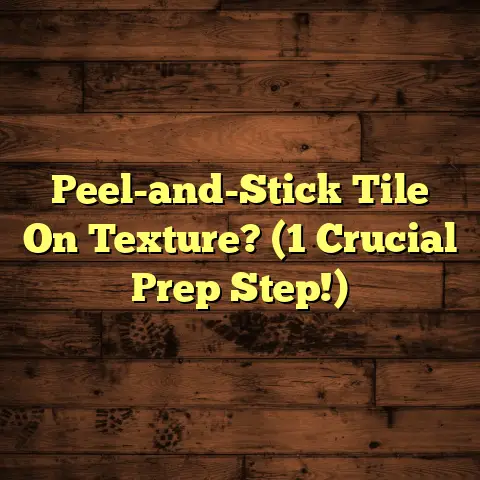Regrout Tile Floor? (4 Grout Types Compared!)
I’m seeing a huge trend right now:
People are loving to revamp their homes, and flooring is a big part of that.
It’s not just about slapping down any old tiles;
it’s about creating spaces that reflect our style.
And guess what?
Grout, that stuff between your tiles, plays a massive role.
I’ve seen a resurgence of classic tile designs, plus the explosion of patterned tiles lately.
This means grout lines are more noticeable than ever before.
Think of it like this:
Your tile is the star, but the grout is the supporting actor that makes the star shine.
That’s why regrouting is becoming so popular.
It’s a relatively easy way to breathe new life into tired-looking floors.
So, you’re thinking about regrouting?
Awesome!
But before you grab a scraper and some new grout, let’s talk about your options.
I’m going to walk you through four different types of grout, each with its own personality.
We’ll explore their pros, cons, and when they shine the brightest.
By the end of this article, you’ll be armed with the knowledge to make the perfect choice for your floors.
Let’s get started!
Section 1: Understanding Grout
Okay, let’s get down to basics.
What is grout, exactly?
Simply put, it’s a dense material used to fill the spaces between tiles.
Think of it as the glue that holds your tile installation together, both literally and figuratively.
But grout does so much more than just fill gaps.
It provides crucial structural integrity, preventing tiles from shifting or cracking.
Perhaps even more importantly, it acts as a barrier against water infiltration, protecting your subfloor from moisture damage.
Trust me, water damage is the last thing you want to deal with!
Over the years, grout materials have evolved quite a bit.
Back in the day, it was pretty basic stuff.
But modern advancements have led to some amazing innovations.
We now have grouts that are stain-resistant, mold-resistant, and even flexible!
This brings us to the four main types of grout I want to cover today:
- Cementitious Grout: The old reliable, and the most common type.
- Epoxy Grout: The tough guy, known for its durability and water resistance.
- Furan Grout: The chemical warrior, often used in industrial settings.
- Ready-to-Use Grout: The DIY-friendly option for quick and easy projects.
In the next sections, we’ll dive deep into each of these grout types, exploring their strengths and weaknesses.
Ready to get started?
Section 2: Type 1 – Cementitious Grout
Alright, let’s kick things off with the workhorse of the grout world: cementitious grout.
This is the most common type you’ll find, and for good reason.
It’s made from a mixture of cement, sand, polymers, and pigments.
When mixed with water, it creates a paste that’s easy to apply and work with.
Pros of Cementitious Grout:
- Affordability: Cementitious grout is generally the least expensive option.
- Availability: You can find it at any home improvement store.
- Ease of Use: It’s relatively easy to mix and apply, even for beginners.
- Color Variety: Available in a huge range of colors to match any tile.
Cons of Cementitious Grout:
- Susceptibility to Staining: This is its biggest weakness. It’s porous, so it easily absorbs spills and stains.
- Cracking: Can crack over time, especially in high-traffic areas or if the subfloor shifts.
- Requires Sealing: Needs to be sealed regularly to protect it from moisture and stains.
- Can Harbor Mold and Mildew: The porous nature makes it a breeding ground for mold.
I’ve seen cementitious grout used in countless projects, from basic bathroom floors to kitchen backsplashes.
It’s a solid choice for areas that aren’t exposed to a lot of moisture or heavy traffic.
For example, I once regrouted a small powder room with cementitious grout.
The homeowner chose a light grey color that complemented the existing tiles perfectly.
It looked fantastic, and because the powder room wasn’t used heavily, it held up well.
However, I always recommend sealing cementitious grout, especially in kitchens and bathrooms.
A good quality sealer will help protect it from stains and moisture.
In terms of maintenance, cementitious grout requires regular cleaning.
I tell my clients to use a pH-neutral cleaner and avoid harsh chemicals, which can damage the grout and sealer.
Compared to other grout types, cementitious grout is less durable and requires more upkeep.
But its affordability and ease of use make it a popular choice for many homeowners.
Here’s a quick comparison with other grout types:
| Feature | Cementitious Grout | Epoxy Grout |
|---|---|---|
| Cost | Low | High |
| Stain Resistance | Low | High |
| Water Resistance | Low | High |
| Durability | Medium | High |
| Maintenance | High | Low |
Section 3: Type 2 – Epoxy Grout
Now, let’s move on to the heavy-duty contender: epoxy grout.
This stuff is a game-changer, especially in areas that see a lot of action or moisture.
Epoxy grout is made from epoxy resins and a hardener.
When these two components are mixed together, they create a chemical reaction that results in a super-strong, waterproof grout.
Advantages of Epoxy Grout:
- Exceptional Stain Resistance: This is its biggest selling point. It’s virtually impervious to stains, even from things like red wine, oil, and grease.
- Waterproof: Perfect for showers, bathrooms, and kitchens where water exposure is a concern.
- Durability: Extremely durable and resistant to cracking, even in high-traffic areas.
- Mold and Mildew Resistance: Non-porous, so it doesn’t harbor mold or mildew.
Disadvantages of Epoxy Grout:
- Higher Cost: Significantly more expensive than cementitious grout.
- More Difficult Installation: Requires more skill and experience to install properly. It sets quickly and can be difficult to clean up if you’re not careful.
- Limited Color Options: Fewer color choices compared to cementitious grout.
I’ve used epoxy grout in several high-end bathroom renovations, and the results are always impressive.
One client, in particular, had a beautiful walk-in shower with intricate tile work.
She was concerned about staining and mold growth, so I recommended epoxy grout.
She was initially hesitant because of the cost, but after seeing the finished product, she was thrilled.
The grout looked fantastic, and she loved the peace of mind knowing it was virtually maintenance-free.
I always tell people that epoxy grout is an investment.
You’ll pay more upfront, but you’ll save money in the long run because you won’t have to worry about staining, mold, or frequent repairs.
However, I also emphasize the importance of proper installation.
Epoxy grout sets quickly, so you need to work fast and clean up any excess grout immediately.
If you’re not comfortable working with it, it’s best to hire a professional.
In terms of maintenance, epoxy grout is a breeze to clean.
Just wipe it down with a damp cloth or mild cleaner.
No sealing required!
Here’s how epoxy grout stacks up against cementitious grout:
| Feature | Cementitious Grout | Epoxy Grout |
|---|---|---|
| Cost | Low | High |
| Stain Resistance | Low | High |
| Water Resistance | Low | High |
| Durability | Medium | High |
| Maintenance | High | Low |
| Installation | Easy | Difficult |
Section 4: Type 3 – Furan Grout
Let’s talk about a grout type you might not have heard of unless you’re dealing with some seriously harsh environments: furan grout.
This isn’t your typical DIY weekend warrior grout.
Furan grout is a thermosetting polymer grout composed of furan resin, a hardener, and fillers.
Unlike cementitious or epoxy grouts, furan grout is known for its exceptional resistance to chemicals, solvents, and high temperatures.
Where Furan Grout Excels:
Furan grout is primarily used in industrial and commercial settings where exposure to harsh chemicals is common.
Think laboratories, food processing plants, breweries, and chemical processing facilities.
It’s also used in some power plants due to its resistance to high temperatures.
Pros of Furan Grout:
- Extreme Chemical Resistance: Unaffected by most acids, alkalis, solvents, and other aggressive chemicals.
- High Temperature Resistance: Can withstand temperatures that would degrade other grout types.
- Low Porosity: Resistant to staining and bacterial growth.
Cons of Furan Grout:
- Challenging Application: Requires specialized skills and equipment for proper installation.
- Strong Odor: Emits a strong, unpleasant odor during installation.
- Limited Color Options: Typically available in a limited range of dark colors.
- High Cost: One of the most expensive grout options available.
- Not Suitable for All Tiles: Can stain certain types of tiles, so compatibility testing is essential.
I haven’t personally used furan grout in many residential projects, simply because the need rarely arises.
However, I have consulted on several commercial projects where it was the only viable option.
For example, a local brewery was having issues with their floors deteriorating due to constant exposure to beer and cleaning chemicals.
I recommended furan grout, and it solved their problem completely.
The floors are now resistant to the chemicals, easy to clean, and hold up for years.
Furan grout is a specialized product for specialized applications.
While it’s not typically used in residential settings, it’s a lifesaver in environments where chemical resistance is paramount.
Here’s a comparison of furan grout with the other grout types:
| Feature | Cementitious | Epoxy | Furan |
|---|---|---|---|
| Chemical Resist. | Low | Medium | Excellent |
| Temp. Resist. | Low | Medium | High |
| Cost | Low | High | Very High |
| Application | Easy | Difficult | Specialized |
Section 5: Type 4 – Ready-to-Use Grout
Finally, let’s talk about the most convenient option for small projects: ready-to-use grout.
As the name suggests, this grout comes pre-mixed in a container, so you can skip the mixing step and get right to work.
Composition and Application:
Ready-to-use grout is typically made from a blend of acrylic or latex polymers, fillers, and pigments.
It’s designed to be easy to apply and clean up, making it a popular choice for DIYers.
When Ready-to-Use Grout Shines:
- Small Regrouting Projects: Perfect for touching up small areas or filling in cracks in existing grout.
- Backsplashes: Ideal for kitchen and bathroom backsplashes where water exposure is minimal.
- DIY Projects: A great option for beginners who want to avoid the hassle of mixing grout.
Performance Comparison:
Compared to traditional grout types, ready-to-use grout has some limitations.
It’s generally less durable and water-resistant than cementitious or epoxy grout.
It may also be more prone to shrinking and cracking over time.
However, it’s still a decent option for low-traffic areas where aesthetics are more important than long-term durability.
Pros of Ready-to-Use Grout:
- Convenience: No mixing required, so it’s quick and easy to use.
- Ease of Application: Smooth and creamy consistency makes it easy to apply.
- Easy Cleanup: Cleans up easily with water.
- Low Odor: Doesn’t have the strong odor associated with epoxy or furan grout.
Cons of Ready-to-Use Grout:
- Lower Durability: Not as durable as cementitious or epoxy grout.
- Less Water Resistance: More susceptible to water damage and staining.
- Shrinkage: Can shrink and crack over time.
- Higher Cost per Volume: More expensive than cementitious grout when comparing cost per volume.
I often recommend ready-to-use grout for small backsplash projects or minor grout repairs.
It’s a great way to quickly refresh the look of a tiled surface without a lot of fuss.
Tips for Best Results:
- Prepare the Surface: Clean the area thoroughly and remove any loose grout.
- Apply Evenly: Use a grout float to apply the grout evenly, making sure to fill all the gaps.
- Remove Excess Grout: Wipe away any excess grout with a damp sponge.
- Allow to Cure: Let the grout cure completely before exposing it to water.
Here’s a quick comparison of ready-to-use grout with the other types:
| Feature | Cementitious | Epoxy | Ready-to-Use |
|---|---|---|---|
| Convenience | Low | Medium | High |
| Durability | Medium | High | Low |
| Water Resist. | Low | High | Low |
| Cost | Low | High | Medium |
Section 6: Comparative Analysis
Okay, we’ve covered a lot of ground.
Let’s take a step back and compare the four grout types side-by-side.
Here’s a handy table that summarizes the key differences:
| Feature | Cementitious | Epoxy | Furan | Ready-to-Use |
|---|---|---|---|---|
| Cost | Low | High | Very High | Medium |
| Application | Easy | Difficult | Specialized | Easy |
| Durability | Medium | High | High | Low |
| Water Resist. | Low | High | High | Low |
| Stain Resist. | Low | High | High | Low |
| Chemical Resist. | Low | Medium | Excellent | Low |
| Maintenance | High | Low | Low | Medium |
| Best Use | General | Wet Areas | Industrial | Small Proj. |
Key Takeaways:
- Cementitious Grout: Best for general use where budget is a concern and water exposure is minimal.
- Epoxy Grout: Ideal for wet areas like showers and bathrooms where stain and water resistance are crucial.
- Furan Grout: The go-to choice for industrial settings where chemical resistance is paramount.
- Ready-to-Use Grout: Perfect for small DIY projects and quick touch-ups.
Choosing the Right Grout:
When choosing a grout, consider the following factors:
- Location: Where will the grout be used? (e.g., bathroom, kitchen, living room)
- Traffic: How much foot traffic will the area receive?
- Moisture Exposure: Will the grout be exposed to water or other liquids?
- Chemical Exposure: Will the grout be exposed to chemicals or solvents?
- Budget: How much are you willing to spend?
- DIY Skills: Are you comfortable installing the grout yourself, or will you hire a professional?
By carefully considering these factors, you can choose the grout that’s best suited for your specific needs.
Conclusion
Grout might seem like a small detail, but it plays a huge role in the overall look and longevity of your tile floors.
Choosing the right grout can make a world of difference.
Whether you’re tackling a full-scale bathroom renovation or just touching up a few cracks in your kitchen backsplash, I hope this article has given you the knowledge and confidence to make the right choice.
Remember, the right grout can not only enhance the appearance of your tile floors but also protect them from damage and keep them looking their best for years to come.
So, take your time, do your research, and choose wisely.
Your floors (and your feet) will thank you!





